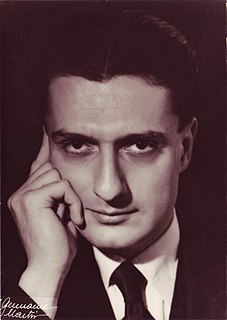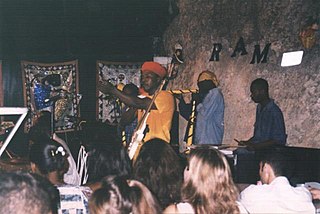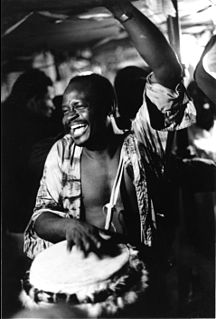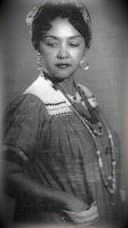
Ludovic Lamothe (12 May 1882 - 4 April 1953) was a Haitian composer and virtuoso pianist. He is considered one of Haiti's most important classical composers. [1]

Ludovic Lamothe (12 May 1882 - 4 April 1953) was a Haitian composer and virtuoso pianist. He is considered one of Haiti's most important classical composers. [1]
A native of Port-au-Prince, he was born into a distinguished literary family, [2] and both his parents were pianists. His grandfather, Joseph Lamothe, was also a noted instrumentalist. Lamothe had his first lessons from his mother and studied the piano and clarinet at the Institution Saint Louis de Gonzague in his native Port-au-Prince where he exhibited exceptional technical and compositional abilities from a young age. [1] In 1910, German merchants in Haiti recognised his talents and funded a scholarship for him to go and continue his studies in Paris, France. There he would study under Louis Diemer at the Paris Conservatory. [1]

Lamothe returned to Haiti in 1911, remaining there for the rest of his life; he taught and gave private recitals on the piano in his home. He gained a reputation for reciting the works of Frédéric Chopin, his favourite composer, and he became known as the "Black Chopin", particularly amongst music scholars and middle-upper class men in Haiti. [1] On one instance Lamothe was invited to perform an event at the Rex Theatre named “Un Chopin Noir” (A Black Chopin) to commemorate the anniversary of the death of Frédéric Chopin. Lamothe recited, among others, Chopin's Polonaise in A Flat. [1]
As a composer, Lamothe wrote exclusively for his own instrument, and became known especially for his songs and short piano pieces. [3] Lamothe's repertoire included a range of méringue, from the most formal, elite-oriented forms to the méringue of the low orders. [1] He was not only influenced by traditional European classical music, but he was influenced by local traditions including Haitian Vodou ceremonial music and carnivals and Haitian peasant culture and influences which reflected a shared African heritage. [1] One scholar has described Lamothe's repertoire as "predominantly classical in form, but creole in inspiration. [4] Another musical scholar, Claude Carré of the online magazine Boutoures has described Lamothe as "representing the nationalist movement in Haitian classical music" and being "an emblematic figure, a piano virtuoso and a performer of Chopin, who left us a number of important compositions for piano." [1]

His fusion of styles and class influences in his music were regarded by scholars as reducing the polarisation in classes in Haiti in the early to mid-twentieth-century Haiti and giving them a unique shared identity through a musical spectrum. [1] One of his notable works is entitled, La Dangereuse, a slow tempo piece with gentle, restrained dynamics, was warmly received by the Haitian aristocracy.
In 1934, Lamothe won a Port-au-Prince city council competition for his "Carnival méringue", which he entitled Nibo. Well received by all walks of society in Haiti, Nibo became known as a Liberation Anthem. a piece to mark the withdrawal of American forces from Haiti in August of that year. [1]
Later in life, Lamothe encountered some serious financial problems, largely due to the fact he had not published many works internationally, only two, and even those were limited to Berlin and Paris, so he was not generating enough income to sustain a living. [1] On 9 February 1944, he was forced to sell up his home that he had lived in much of his life, but his continued musical status amongst the elite in Haiti meant that enough money was raised to aid him in buying a new home. [1]
Lamothe later went on to become Chief of Music of the Republic of Haiti. He died in Port-au-Prince in 1953. Although little of his music was published even in his native Haiti during his life, after his death his family collected his manuscripts and had them printed privately. A collection of his pieces was published in Port-au-Prince in 1955, entitled simply, Musique de Ludovic Lamothe. [5]
In 2001, a CD recording of Lamothe was published on the IFA Music Records label, released in 2001 featuring some of his pieces, the Ballade in A Minor, Danza No. 1 (La Habanera), Evocation, and Danse Espagnole No. 4, performed by Latino-Caribbean pianist, Charles P. Phillips. [1]
In 2006, a book entitled Vodou Nation: Haitian Art Music and Cultural Nationalism by the Chicago Studies in Ethnomusicology cited numerous examples of Lamothe's compositions to illustrate his cultural contribution to Vodou music. They cited in particular, La Dangereuse, Nibo, Sous la Tonnelle, Loco and Sobo. [5]
The music of Haiti combines a wide range of influences drawn from the many people who have settled on this Caribbean island. It reflects French, African rhythms, Spanish elements and others who have inhabited the island of Hispaniola and minor native Taino influences. Styles of music unique to the nation of Haiti include music derived from rara parading music, twoubadou ballads, mini-jazz rock bands, rasin movement, hip hop Creòle, the wildly popular compas, and méringue as its basic rhythm. Haiti hadn't had a recorded music until 1937 when Jazz Guignard was recorded non-commercially. One of the most current popular Haitian artists is Wyclef Jean. His music is somewhat hip hop mixed with worldbeat. Haitian music is influenced mostly by European colonial ties and African migration. In the case of European colonization, musical influence has derived primarily from the French.

Louis Moreau Gottschalk was an American composer and pianist, best known as a virtuoso performer of his own romantic piano works. He spent most of his working career outside of the United States.

Johann Nepomuk Hummel was an Austrian composer and virtuoso pianist. His music reflects the transition from the Classical to the Romantic musical era. He was a pupil of Mozart, Salieri and Haydn. He was also friends with Beethoven and Schubert.

Charles Welles Rosen was an American pianist and writer on music. He is remembered for his career as a concert pianist, for his recordings, and for his many writings, notable among them the book The Classical Style.

Constantin "Dinu" Lipatti was a Romanian classical pianist and composer whose career was cut short by his death from causes related to Hodgkin's disease at age 33. He was elected posthumously to the Romanian Academy. He composed few works, all of which demonstrated a strong influence from Bartok.

The culture of Haiti is an eclectic mix of African, Taino and European elements due to the French colonization of Saint Domingue and its large and diverse enslaved African population, as is evidenced in the Haitian language, music, and religion.
Compas is a modern méringue dance music of Haiti. The genre was popularized following the creation of Ensemble Aux Callebasses in (1955), which became Ensemble Nemours Jean-Baptiste In 1957. The frequent tours of the many Haitian bands have cemented the style in all the Caribbean. Therefore, compas is the main music of several countries such as Dominica and the French Antilles. Whether it is called zouk, where French Antilles artists of Martinique and Guadeloupe have taken it, or compas in places where Haitian artists have toured, this méringue style is influential in part of the Caribbean, Portugal, Cape Verde, France, part of Canada, South and North America.
Musical nationalism refers to the use of musical ideas or motifs that are identified with a specific country, region, or ethnicity, such as folk tunes and melodies, rhythms, and harmonies inspired by them.

RAM is a mizik rasin band based in the city of Port-au-Prince, Haiti. The band derives its name from the initials of its founder, songwriter, and lead male vocalist, Richard A. Morse. The band's music has been described by Morse as "Vodou rock 'n' roots", and has been one of the prominent bands in the mizik rasin musical movement in Haiti. RAM began performing together in 1990, and recorded their first album in 1996. The band's music incorporates traditional Vodou lyrics and instruments, such as rara horns and petro drums, into modern rock and roll. The band's songs include lyrics in Haitian Creole, French, and English.
Olatunji Akin Euba, was a Nigerian composer, musicologist, and pianist.
Méringue, also called méringue lente or méringue de salon, is a dance music and national symbol in Haiti. It is a string-based style played on the lute, guitar, horn section, piano, and other string instruments unlike the accordion-based merengue, and is generally sung in Haitian Creole and French, as well as in English and Spanish.

Émile Louis Fortuné Pessard was a French composer.

Institution Saint-Louis de Gonzague is a primary and secondary Roman Catholic school in Port-au-Prince, Haiti. It was founded and is run by the Brothers of Christian Instruction (FIC). The school colors are red and green.

Werner Anton Jaegerhuber was a Haitian composer known for composing "Messe sur les Airs Vodoussques", "Musique pour Aieules", "Naissa" and many others.

Frisner Augustin was a major performer and composer of Haitian Vodou drumming, and the first and only citizen of Haiti to win a National Heritage Fellowship from the National Endowment for the Arts in the United States, where he resided for forty years.
Wim Statius Muller was a Curaçaoan composer and pianist, nicknamed "Curaçao's Chopin" for his romantic piano stylings. Although he was a Juilliard graduate, his musical career did not begin in earnest until after he retired from a career in security and counterintelligence.
Michel Mauléart Monton (1855–1898), was a Haitian musician, pianist and composer. He became famous for composing the music for the méringue classic, choucoune

Justin Elie was a Haitian composer and pianist. He is one of the best-known composers outside of Haiti.

Lina Mathon-Blanchet was a Haitian pianist, music teacher and composer. First director of the Conservatoire National, she was interested in Haiti's folkloric traditions and was one of the first performers to include Vodou-influenced theatrical performances on the public stage in the country. Founding several folkloric troupes, she led her artists on tours throughout the United States and was noted as a teacher and mentor to many prominent Haitian performers. Trained in classical music traditions she collected traditional songs documenting the lyrics, melodies, and rhythms found as traditional themes in Haitian music. She is widely recognized as one of the most influential figures in the development of music in Haiti in the twentieth-century.